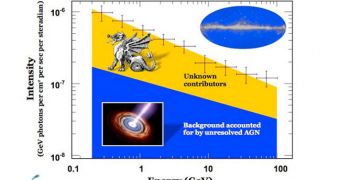Over the past few years, experts working in studying the mysteries of the Universe have determined that highly-energetic gamma-rays are produced by active galactic nuclei (AGN). This knowledge was based on scientific observations of the sky, using advanced telescopes and techniques. However, it would now seem that the experts were mislead, as evidenced by new data collected from the NASA Fermi Gamma-ray Telescope. In other words, all the theories are now of no use, and researchers are again back to square one in solving the origins of this mysterious radiation, Space reports.
The thing about these highly-energetic photons is that they permeate the Universe in all directions, which means that they must be produced in a lot of sources at the same time. Astronomers have determined in their investigations that the radiation exists even very far away from known sources, such as pulsars, or gas clouds within galaxies. Many experts believed that the AGN might have been other sources for this radiation. These structures are very compact regions at the core of massive galaxies that shine very bright in most regions of the electromagnetic spectrum.
“Thanks to Fermi, we now know for certain that this is not the case,” explained KIPAC astrophysicist Marco Ajello. The Kavli Institute for Particle Astrophysics and Cosmology is operated by the US Department of Energy's (DOE) SLAC National Accelerator Laboratory, and the Stanford University, in California. Using data from the Fermi observatory, experts at the Institute determined that AGN simply did not produce the necessary amount of gamma-rays needed to support the cosmic background.
“Active galaxies can explain less than 30 percent of the extragalactic gamma-ray background Fermi sees. That leaves a lot of room for scientific discovery as we puzzle out what else may be responsible,” Ajello said yesterday, at the meeting of the American Astronomical Society (AAS) High-Energy Astrophysics Division, in Hawaii. Details of the new Fermi studies were also submitted for publication in an upcoming issue of the respected scientific publication The Astrophysical Journal. Some believe that the background may be in fact produced by dark matter. “Dark matter may be a type of as-yet-unknown subatomic particle. If that's true, dark matter particles may interact with each other in a way that produces gamma rays,” the KIPAC scientist concluded.

 14 DAY TRIAL //
14 DAY TRIAL //